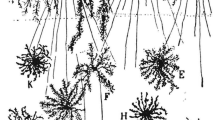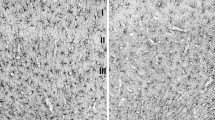Abstract
Previous observations disclosed that astroglia with interlaminar processes were present in the cerebral cortex of adult New and Old World monkeys, but not in the rat, and scarcely in the prosimian Microcebus murinus. The present report is a more systematic and comprehensive comparative analysis of the occurrence of such processes in the cerebral cortex of several mammalian species. Brain samples were obtained from adult individuals from the following orders: Carnivora (canine), Rodentia (rat and mouse), Marsupialia (Macropus eugenii), Artiodactyl (bovine and ovine), Scandentia (Tupaia glis), Chiroptera (Cynopteris horsfieldii and C. brachyotis), and Primate: Prosimian (Eulemur fulvus), non-human primate species (Cebus apella, Saimiri boliviensis, Callithrix, Macaca mulatta, Papio hamadryas, Macaca fascicularis, Cercopithecus campbelli and C. ascanius) and from a human autopsy. Tissues were processed for immunocytochemistry using several antibodies directed against glial fibrillary acidic protein (GFAP), with or without additional procedures aimed at the retrieval of antigens and enhancement of their immunocytochemical expression. The cerebral cortex of non-primate species had an almost exclusive layout of stellate astrocytes, with only the occasional presence of long GFAP-IR processes in the dog that barely crossed the extent of lamina I, which in this species had comparatively increased thickness. Species of Insectivora and Chiroptera showed presence of astrocytes with long processes limited to the ventral basal cortex. Interlaminar GFAP-IR processes were absent in Eulemur fulvus, at variance with their limited presence and large within- and inter-individual variability as reported previously in Microcebus murinus. In New World monkeys such processes were absent in Callithrix samples, at variance with Cebus apella and Saimirí boliviensis. Overall, the expression of GFAP-IR interlaminar processes followed a progressive pattern: bulk of non-primate species (lack of interlaminar processes) –Chiroptera and Insectivora (processes restricted to allocortex) <strepsirhini <haplorhini (platirrhini<catarrhini). This trend is suggestive of the emergence of new evolutionary traits in the organization of the cerebral cortex, namely, the emergence of GFAP-IR long, interlaminar processes in the primate brain. Interlaminar processes may participate in a spatially restricted astroglial role, as compared to the one provided by the astroglial syncytium. It is proposed that the widely accepted concept of an exclusively astroglial syncytium is probably linked with a specific laboratory animal species (”rodent-type” or, rather, ”general mammalian-type” model) that misrepresents the astroglial architecture present in the cerebral cortex of most anthropoid adult primates (”primate-type” model), including man.
Similar content being viewed by others
Author information
Authors and Affiliations
Additional information
Accepted: 28 June 1999
Rights and permissions
About this article
Cite this article
Colombo, J., Fuchs, E., Härtig, W. et al. ”Rodent-like” and ”primate-like” types of astroglial architecture in the adult cerebral cortex of mammals: a comparative study. Anat Embryol 201, 111–120 (2000). https://doi.org/10.1007/PL00008231
Issue Date:
DOI: https://doi.org/10.1007/PL00008231




